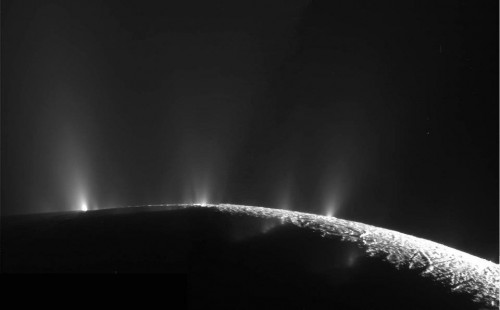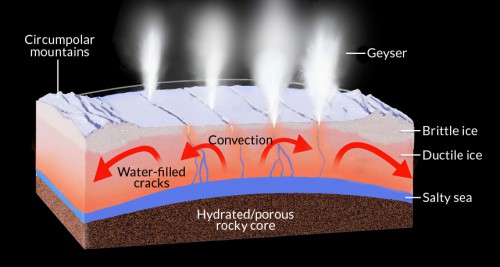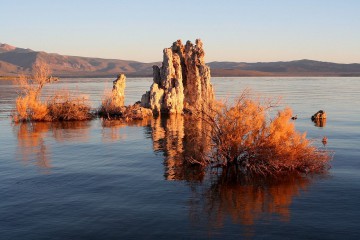
Along with Jupiter’s infamous moon Europa, Saturn’s moon Enceladus is one of the most fascinating places in the Solar System, with its huge geysers of water vapor erupting from cracks in the surface at the south pole. The massive plumes are now thought to originate in a subsurface ocean or sea of salty liquid water, similar perhaps to Europa’s underground ocean. Now, new analysis is providing a more detailed look at the chemical makeup of this unique alien environment and its potential to support life.

The Cassini spacecraft orbiting Saturn has made many close flybys of this intriguing moon, including directly through some of the saltwater spray in the plumes themselves (over 100 individual plumes counted to date), “tasting” them as it did so. So far, scientists know that the plumes contain water vapor, ice particles, salts, and organic material. This has already shown that the water below is similar in ways to the water in oceans on Earth. Needless to say, this has caused some excitement among planetary scientists, and the public as well, as it presents the possibility of some form of life existing in the Enceladian ocean. Cassini itself can’t confirm or deny that, but it can provide important clues as to the actual conditions in this strange environment and whether they could support life.
As it turns out, they could, although the ocean may be more salty than most ocean life on Earth is used to. From the press release:
“The model indicates that Enceladus’ ocean is a Na-Cl-CO3 solution with an alkaline pH of ~11-12. The dominance of aqueous NaCl is a feature that Enceladus’ ocean shares with terrestrial seawater, but the ubiquity of dissolved Na2CO3 suggests that soda lakes are more analogous to the Enceladus ocean.”
Basically, the water contains a lot of dissolved sodium carbonate (Na2CO3), a sodium salt. The pH level is higher than usual, about 11-12 (seawater on Earth is typically about 8.08 to 8.33). So, if as indicated by these preliminary studies, the water inside Enceladus is similar to soda lakes on Earth, which are highly alkaline (very salty).

This may sound like a rather inhospitable environment, but at least on Earth, that is not true. Such high-salinity soda lakes host complex ecosystems with a rich variety of prokaryotes (bacteria and archaeabacteria), eukaryotic algae, protists, and fungi. Brine shrimp and fish have also been found in some of the lesser alkaline soda lakes. Some species, known as alkaliphiles, have adapted specifically to the soda lakes and would be unable to live in a more neutral-pH environment. From the published paper:
“Knowledge of the pH dramatically improves our understanding of geochemical processes in Enceladus’ ocean. In particular, the high pH is interpreted to be a key consequence of serpentinization of chondritic rock, as predicted by prior geochemical reaction path models, although degassing of CO2 from the ocean may also play a role depending on the efficiency of mixing processes in the ocean. Serpentinization inevitably leads to the generation of H2, a geochemical fuel that can support both abiotic and biological synthesis of organic molecules such as those that have been detected in Enceladus’ plume.

Serpentinization and H2 generation should have occurred on Enceladus, like on the parent bodies of aqueously altered meteorites; but it is unknown whether these critical processes are still taking place, or if Enceladus’ rocky core has been completely altered by past hydrothermal activity. The presence of native H2 in the plume would provide strong evidence for contemporary aqueous alteration. The high pH also suggests that the delivery of oxidants from the surface to the ocean has been sporadic, and the rocky core did not experience partial melting and igneous differentiation. On the other hand, the deduced pH is completely compatible with life as we know it; indeed, life on Earth may have begun under similar conditions, and terrestrial serpentinites support thriving microbial communities that are centered on H2 that is provided by water-rock reactions. These considerations provide major motivation for future missions to explore Enceladus as a habitable world, whether past or present.”
On Earth, soda lakes tend to be found in arid and semi-arid regions and in connection to tectonic rifts. Photosynthesis is the primary energy source for the lakes’ inhabitants, although deeper down, anoxygenic photosynthesizers and sulfur-reducing bacteria are also common. Similar kinds of non-carbon dioxide energy sources, including sulfur or nitrogen, would be required in oceans such as those in Enceladus or Europa, where no sunlight can reach the water below due to the surface ice crust.
Such a high-salinity ocean might not be the most ideal environment as far as life as we know it is concerned, but it is by no means a show-stopper, as the soda lakes on Earth have shown. If life ever started in the Enceladus ocean, there is seemingly no reason why it couldn’t have evolved and adapted to its environment. Cassini has already found organics in the watery plumes; could there be life itself? The only way to know will be to return to this moon with a spacecraft able to search for biomarkers in the plumes or even microorganisms themselves, which might get ejected out from the water below. Either would, of course, be a fantastic discovery.
The new paper, titled “The pH of Enceladus’ Ocean,” is available here, and more information about Cassini and Enceladus is here.
Want to keep up-to-date with all things space? Be sure to “Like” AmericaSpace on Facebook and follow us on Twitter: @AmericaSpace




Paul,
Considering we have definitive proof of water within this moon wouldn’t it make sense to send a probe here rather than Europa where the water has not been confirmed?
Let’s send at least one probe to each moon for comparative studies.